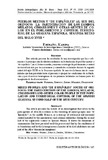| dc.rights.license | http://creativecommons.org/licenses/by-nc-sa/3.0/ve/ | es_VE |
| dc.contributor.author | Estraño, Karina | |
| dc.date.accessioned | 2018-06-27T19:42:03Z | |
| dc.date.available | 2018-06-27T19:42:03Z | |
| dc.date.issued | 2018 | |
| dc.identifier.issn | 1325-2610 | |
| dc.identifier.uri | http://www.saber.ula.ve/handle/123456789/45089 | |
| dc.description.abstract | Este artículo presenta los resultados de una investigación que hace referencia
a la participación de afrodescendientes en la fundación de pueblos mixtos y
“de españoles”, en el Orinoco medio, como una estrategia de poblamiento y control
territorial iniciada por los misioneros y autoridades coloniales durante la segunda
mitad del siglo XVIII en la Guayana española. Se muestra la formación de comunidades
que han persistido hasta el presente y que por las condiciones de su fundación
y por el carácter heterogéneo de sus primeros habitantes no forman parte del
imaginario de lo afrovenezolano. | es_VE |
| dc.language.iso | es | es_VE |
| dc.publisher | SABER-ULA | es_VE |
| dc.rights | info:eu-repo/semantics/openAccess | es_VE |
| dc.subject | Guayana | es_VE |
| dc.subject | Orinoco | es_VE |
| dc.subject | Zambo | es_VE |
| dc.subject | Mulatos | es_VE |
| dc.subject | Cimarrones | es_VE |
| dc.title | Pueblos mixtos y “de españoles” al sur del Orinoco: la participación de los zambos, mulatos, cimarrones y otras gentes de color en el poblamiento y control territorial de la Guayana española. Segunda mitad del siglo XVIII | es_VE |
| dc.title.alternative | Mixed peoples and “de españoles” south of Orinoco: the participation of the zambos, mulatos, cimarrones and other color people in the population and territorial control of the spanish Guayana. Second half of the 18th century | es_VE |
| dc.type | info:eu-repo/semantics/article | es_VE |
| dcterms.dateAccepted | 18- 01-2018 | |
| dcterms.dateSubmitted | 14-10-2017 | |
| dc.description.abstract1 | This article presents the results of an investigation that refers to the
participation of Afro-descendants in the founding of mixed peoples and “of
Spaniards”, in the middle Orinoco, as a strategy of settlement and territorial
control initiated by the missionaries and colonial authorities during the second
half of the eighteenth century in Spanish Guiana. It shows the formation of
communities that have persisted until the present and that by the conditions of
its foundation and by the heterogeneous character of its first inhabitants are not
part of the Afro-Venezuelan imaginary. | es_VE |
| dc.description.colacion | 165-192 | es_VE |
| dc.description.email | karina.estrano@gmail.com | es_VE |
| dc.description.frecuencia | semestral | |
| dc.identifier.edepositolegal | ppi201403ME788 | |
| dc.identifier.eissn | 2542-3304 | |
| dc.publisher.pais | Venezuela | es_VE |
| dc.subject.dependencia | Museo Arqueológico "Gonzalo Rincón Gutiérrez" | es_VE |
| dc.subject.institucion | Universidad de Los Andes | es_VE |
| dc.subject.institutoinvestigacion | Centro de Investigaciones Etnológicas (CIET) | |
| dc.subject.keywords | Guiana | es_VE |
| dc.subject.keywords | Orinoco | es_VE |
| dc.subject.keywords | Zambo | es_VE |
| dc.subject.keywords | Mulatos | es_VE |
| dc.subject.keywords | Cimarrones | es_VE |
| dc.subject.publicacionelectronica | Boletín Antropológico | |
| dc.subject.seccion | Boletín Antropológico: Artículos | es_VE |
| dc.subject.thematiccategory | Artes y Humanidades | es_VE |
| dc.subject.tipo | Revistas | es_VE |
| dc.type.media | Texto | es_VE |


